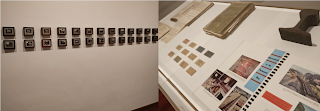KL Biennale (VIII): Second Floor Galleries
For the interested visitor, the second floor KL Biennale exhibition area in the National Art Gallery, presents an incoherent and challenging display. The immersive “Cracks in the Wall” presentation by Leon Leong greets those walking up the stairs. A draped “Under Construction” installation greets one walking up the rotunda, its censored form and state, not made known to the uninformed. Siti Zainon Ismail’s “Rumah Waris Uwan” proposes a visit to one kampung house six kilometres away, that cannot be found on Google Maps, thereby decreasing the prospects of proposed trip. Entering Galeri 2B next, pastel-tone photographs of “Swedish Dads” cuddling their offspring, and other works featuring children are displayed. While Zakaria Awang’s solemn ‘Warkah Buat Anakanda’ is undoubtedly the centrepiece within these small galleries, the remaining presentation is disjointed.
 |
| Installation snapshot of Zakaria Awang – Warkah Buat Anakanda (2012) |
The cavernous Galeri 2A projects a better first impression, with a presentation of 80-years old paintings by O. Don Peris, along with photographs taken by his son Eric Peris. Unfortunately, Eric’s “Flower Does Not Talk” series is displayed in lightboxes which require the gallery to be dimmed, thus rendering works from the senior Peris illegible (or was this done due to preservation concerns?). The immediate galleries to the left changed its displays between November 2017 and December 2018, revealing the unrealistic timeline curators and artist representatives were working towards. In the final presentation, H.H. Lim’s expressionist painting, surreal cage, and fishing video are displayed, along with two wall hangings that depict human suffering. At this point, it is worth pondering the relevance of exhibits, with regards to the gallery’s biennale sub-theme Belas Insan.
 |
| Installation snapshot of Amir Zainorin – Tong Tana (2017) |
Small photographic portraits by Diana Lui and Jeffrey Lim captivate, while subsequent white & black box galleries include a variety of public engagement evidence. Before a common thread between these exhibits is established, the show veers off to works categorized under the sub-theme Belas Warisan. Three wooden sculptures by Tengku Sabri Ibrahim stand unsure of its positions, its blurry shadows wavering underneath the spotlight. Patterned constructs and paintings of traditional motifs surround a suspended fabric sculpture by Yim Yen Sum, while selected prints from Ilse Noor’s “Warisan Nusa” series are hung around the corner. The short walkway then continues into, a dark room showing Nasir Baharuddin’s large video projection ‘NT Ext Neuro’. This interchange of sub-themes in the middle of the gallery layout, disrupts an already tenuous flow, which implies a tentative exhibition strategy.
 |
| Installation snapshots of Mahen Bala – 222KM (2016–2017) |
Squinting at Novia Shin’s tiny creations at the corners of the black box gallery, it is apparent that some exhibits are at risk of being a space filler, rather than a space disrupter. The final two gallery spaces, connected by a passage covered in brown paper, attempts to portray Malaysia as a culturally diverse place. Many works are excellent if evaluated standalone, but as a group, the presentation fails and appears contrived. This area is anchored by Ismadi Salehuddin’s collage of a Malaysian flag, made from wooden scraps. The symbol is as broken as its visible gaps, and casts a sinister light on neighbouring works by Sabah & Sarawak-born artists, and a spectral display memorializing Pudu Jail by K. Azril Ismail. In the preceding gallery, heroic sculptures by Raja Shahriman Raja Aziddin, coexist uncomfortably with paintings of indigenous motifs by Kelvin Chap. What was made from loss, and what is lost from made?
 |
| Installation snapshots of Galeri 2A, with works by Kelvin Chap, Shia Yih Yiing, Raja Shahriman Raja Aziddin, and Mad Anuar Ismail |
Comments
Post a Comment